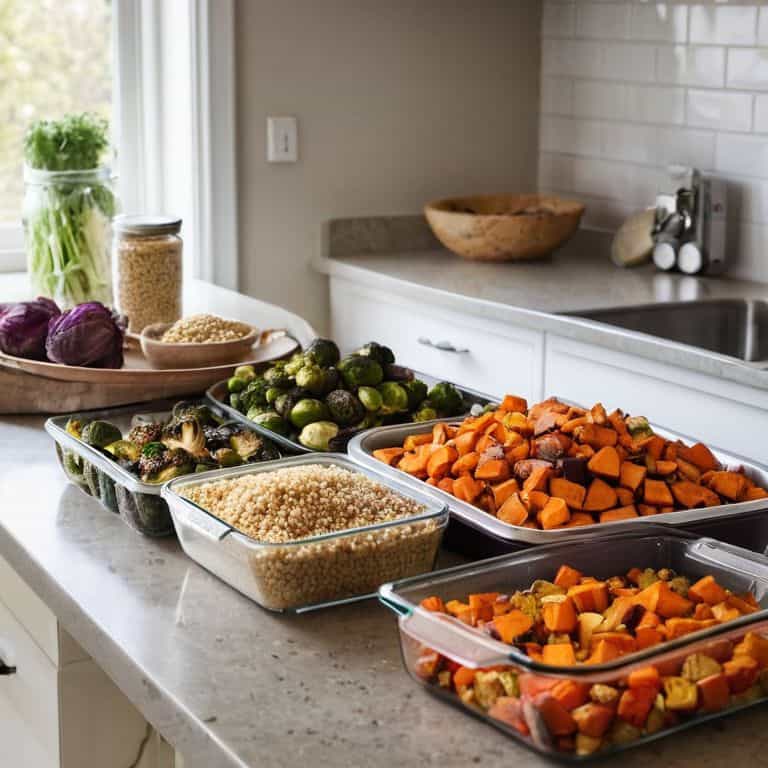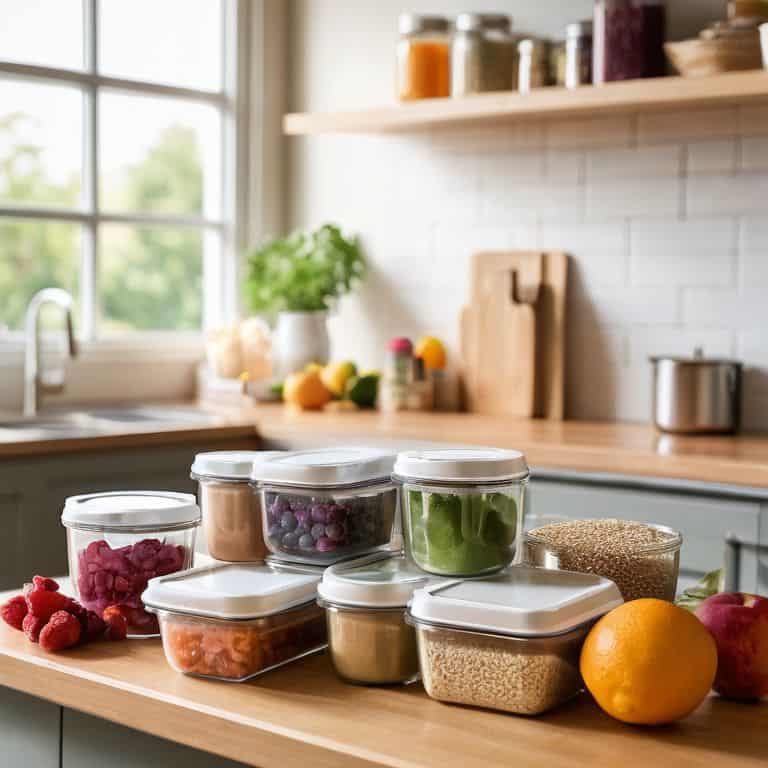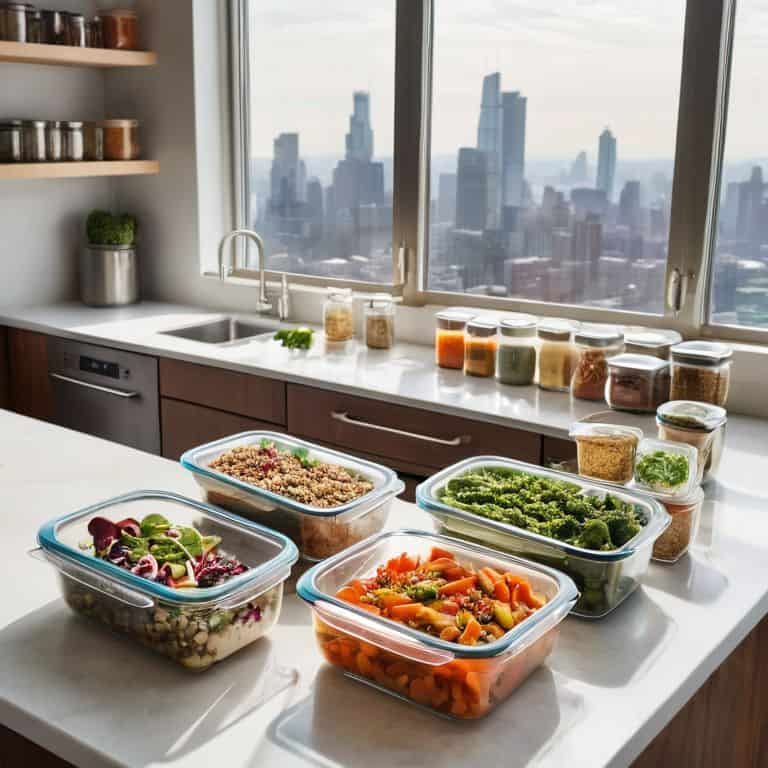I still remember the Sunday evenings I used to spend frantically planning my meals for the week, only to end up ordering takeout by Wednesday. As someone who’s passionate about helping others create systems out of chaos, I’ve learned that meal prep for busy people doesn’t have to be a daunting task. In fact, it’s often the key to unlocking a more balanced and productive lifestyle. The common myth that meal prep has to be time-consuming and boring is simply not true – with the right approach, it can be a game-changer for those with limited time.
In this article, I’ll share my personal, tried-and-tested strategies for making meal prep for busy people a reality. You’ll learn how to break down the process into manageable steps, from planning and grocery shopping to cooking and portioning. My goal is to provide you with practical, actionable advice that you can apply to your own life, without any fluffy jargon or unrealistic expectations. By the end of this guide, you’ll be equipped with the tools and confidence to create a meal prep system that works for you, not against you.
Table of Contents
Guide Overview: What You'll Need

Total Time: 1 hour 30 minutes
Estimated Cost: $20 – $50
Difficulty Level: Easy
Tools Required
- Large Cooler for storing meals
- Reusable Containers various sizes
- Label Maker for labeling containers
Supplies & Materials
- Fresh Fruits such as apples, bananas
- Leafy Greens like kale, spinach
- Proteins like chicken, beans, lentils
- Whole Grains like brown rice, quinoa
- Spices and Herbs for added flavor
Step-by-Step Instructions
- 1. First, let’s get started with setting your meal prep goals. Take some time to reflect on what you want to achieve with meal prep – is it to save time, eat healthier, or simply reduce food waste? Write down your goals and make them specific, measurable, and attainable. For example, “I want to prep my lunches for the next 5 days to save 30 minutes each morning” or “I aim to reduce my weekly food budget by 20% through meal prep”. This will help you stay focused and motivated throughout the process.
- 2. Next, plan your meals for the next few days. Consider your schedule, dietary restrictions, and personal preferences. You can find inspiration online or use a meal planning app to make it easier. Make a list of the meals you want to prep, including breakfast, lunch, dinner, and snacks. Be sure to include a variety of foods to keep your meals interesting and nutritious.
- 3. Now it’s time to make a grocery list. Based on your meal plan, write down all the ingredients you need to buy. Check what you already have in your pantry, fridge, and freezer to avoid duplicates. Organize your list by store sections (e.g., produce, meats, dairy) to make shopping more efficient. You can also use a grocery list app to make it easier to manage and share with others.
- 4. Once you have your list, head to the store and start shopping. Try to buy ingredients that can be used in multiple meals to reduce waste and save time. Consider purchasing pre-chopped or pre-cooked items to save time on meal prep day. Don’t forget to check the sales and stock up on non-perishable items to save money in the long run.
- 5. After you’ve returned from the store, it’s time to prep your ingredients. Wash, chop, and portion out your ingredients according to your meal plan. Use airtight containers or ziplock bags to store your prepped ingredients and label them with the meal and date. This will save you time during the week when you’re assembling your meals.
- 6. Next, assemble your meals. Use your prepped ingredients to assemble your meals for the next few days. Consider using a “assembly-line” approach, where you prepare each component of the meal (e.g., protein, veggies, grains) and then assemble them into individual portions. This can be a fun and therapeutic process, and you can even listen to music or podcasts while you work.
- 7. Finally, store and reheat your meals. Use airtight containers or microwave-safe bags to store your meals in the fridge or freezer. Label each container with the meal name, date, and reheating instructions. When you’re ready to eat, simply reheat your meal according to the instructions and enjoy. Be sure to check the temperature of your meals to ensure food safety.
- 8. To keep your meal prep system running smoothly, schedule regular prep days. Set a reminder on your calendar to prep your meals for the next few days, whether it’s weekly, bi-weekly, or monthly. This will help you stay on track and ensure that you always have healthy, delicious meals ready to go. Consider setting aside a specific day and time each week, such as Sunday evening, to prep your meals for the upcoming week.
Meal Prep for Busy People

When it comes to implementing a meal prep system, I always recommend starting with quick and easy meal prep ideas that can be adapted to your lifestyle. This might mean preparing a large batch of rice or quinoa on the weekend, or roasting a tray of vegetables that can be used in various meals throughout the week. By focusing on simple, versatile ingredients, you can create a variety of healthy meals without feeling overwhelmed.
As someone who’s worked with numerous clients on healthy meal prep on a budget, I can attest that it’s all about planning ahead and making the most of your grocery list. Consider investing in some good-quality meal prep containers for sale that will keep your food fresh and organized. This small investment can make a big difference in the long run, especially if you’re someone who values convenience and efficiency.
For those just starting out, I recommend exploring batch cooking for beginners resources online, which often include helpful tips and recipes to get you started. You can also find plenty of meal prep planning templates that will help you stay on track and ensure you’re making the most of your time in the kitchen. By taking a structured approach to meal prep, you’ll be amazed at how much more manageable it becomes, even on the busiest of days.
Healthy Meal Prep on a Budget
To make meal prep work on a budget, start by planning your meals around what’s in season and on sale. I like to break it down into a simple flowchart: identify your protein sources, pick a few versatile veggies, and choose whole grains that can be used in multiple dishes. This helps reduce food waste and saves you money.
By buying in bulk and portioning out ingredients, you can create healthy, budget-friendly meals that fit your busy lifestyle. I’ve found that a little planning can go a long way in saving time and money, all while eating nutritious food that fuels your body.
Quick and Easy Meal Prep Ideas
When it comes to meal prep, I always say: start small, start simple. You don’t need to overhaul your entire kitchen or spend hours cooking up a storm. Some of my favorite quick and easy meal prep ideas include overnight oats, one-pot wonders, and good old-fashioned salads in a jar. These are perfect for busy mornings when you need something fast, but still healthy and delicious.
I like to break it down into bite-sized tasks: cook a protein like chicken or tofu on the weekend, roast some veggies, and then assemble everything into individual containers for the week ahead. It’s all about finding those little pockets of time and using them to your advantage. Trust me, it’s worth it – and it’s a total game-changer for busy humans like us.
5 Essential Meal Prep Tips for Busy Bees Like Us
- Plan Your Meals Around Your Schedule: Take some time to review your week ahead and plan your meals accordingly, considering your busiest days and how you can prep in advance to save time
- Shop Smart, Not Hard: Make a grocery list based on your meal plan and try to buy ingredients that can be used in multiple meals to reduce food waste and save you time in the long run
- Prep in Bulk, Save Time: Consider cooking proteins like chicken, rice, or grains in large batches on the weekends or one day a week, and then use them throughout the week in different meals
- Keep it Simple, Keep it Fresh: Don’t feel like you need to create elaborate meals, focus on simple, nutritious dishes that can be prepared quickly and reheated as needed, like soups, salads, or stir-fries
- Label and Date Everything: Use a label maker to keep track of what you’ve prepped and when, this will help you ensure you’re using the oldest items first and reduce food waste, plus it’s just really satisfying to have a organized fridge
Key Takeaways for Busy Meal Preppers
By breaking down meal prep into simple, manageable steps, you can save time and reduce stress in your daily routine
Implementing a meal prep system can help you stick to a healthy diet even on a tight budget, with a little planning and creativity
Remember, the goal of meal prep is not to add another chore to your list, but to create a sustainable habit that supports your overall well-being and productivity
Breaking Down Barriers to Healthy Eating
Meal prep isn’t about having it all together; it’s about breaking down the chaos of our daily lives into manageable, bite-sized pieces – literally.
Sloane Kendrick
Bringing It All Together: Meal Prep for Busy Humans

As we’ve explored in this guide, meal prep can be a total game-changer for busy people like you and me. We’ve broken down the process into simple, actionable steps: from quick and easy meal prep ideas to healthy meal prep on a budget. By following these steps, you can create a system that works for your unique lifestyle and preferences, saving you time and reducing stress in the long run. Whether you’re a fan of intricate infographics like I am, or you just appreciate a good flowchart, the key is to find a method that helps you stay organized and focused.
So, as you move forward with your meal prep journey, remember that it’s all about progress, not perfection. Don’t be too hard on yourself if you miss a day or two – simply get back on track and keep moving forward. With time and practice, you’ll find that meal prep becomes an integral part of your daily routine, freeing up more time for the things that truly matter in your life. And if you ever need a reminder, just grab a marker and start mapping out your goals on a whiteboard – sometimes, all it takes is a fresh perspective to get back on track and start achieving your dreams.
Frequently Asked Questions
How can I ensure I'm preparing healthy meals that my whole family will enjoy, even on a tight schedule?
To ensure healthy meals your whole family will enjoy, start by involving them in the planning process. Ask about their favorite foods and dietary needs. Then, create a weekly meal calendar with simple, versatile recipes that can be prepped in advance. This will help you stay organized and ensure everyone looks forward to mealtimes.
What are some space-saving strategies for storing meal prep containers in a small kitchen?
To maximize space in a small kitchen, I recommend using stackable containers, hanging a pegboard for frequently used items, and designating a specific ‘meal prep station’ with a compact cart or tray to keep everything organized and within reach.
Can I still do meal prep if I have dietary restrictions, such as gluten-free or vegan, and how can I make sure I'm getting all the necessary nutrients?
Absolutely, dietary restrictions don’t have to derail your meal prep goals. As a life systems coach, I recommend creating a personalized flowchart to map out your nutritional needs and preferences. For gluten-free or vegan diets, focus on whole foods, and explore alternative protein sources like legumes or tofu to ensure you’re getting all the necessary nutrients.
